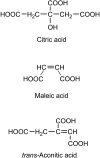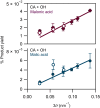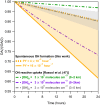Humidity drives spontaneous OH oxidation of organic particles
- PMID: 40540571
- PMCID: PMC12180490
- DOI: 10.1126/sciadv.adx4507
Humidity drives spontaneous OH oxidation of organic particles
Abstract
We report evidence that organic aerosols containing carboxylic acids can be spontaneously oxidized in the dark under normal atmospheric conditions due to interfacial hydroxyl radical production. Product formation is negligible under dry conditions and increases with increasing relative humidity. In a dioxygen-free environment, the oxidation efficiency is substantially decreased. Size-resolved measurements show an increase in the reactivity and product formation yields for smaller particles, correlated with their surface-to-volume ratio. Our findings suggest that spontaneous hydroxyl radical production at the air-water interface of organic nanodroplets may be an important pathway in their oxidation, especially during nighttime.
Figures





Similar articles
-
Routine vaginal examinations compared to other methods for assessing progress of labour to improve outcomes for women and babies at term.Cochrane Database Syst Rev. 2022 Mar 4;3(3):CD010088. doi: 10.1002/14651858.CD010088.pub3. Cochrane Database Syst Rev. 2022. PMID: 35244935 Free PMC article.
-
Orthodontic treatment for crowded teeth in children.Cochrane Database Syst Rev. 2021 Dec 31;12(12):CD003453. doi: 10.1002/14651858.CD003453.pub2. Cochrane Database Syst Rev. 2021. PMID: 34970995 Free PMC article.
-
Humidification of indoor air for preventing or reducing dryness symptoms or upper respiratory infections in educational settings and at the workplace.Cochrane Database Syst Rev. 2021 Dec 10;12(12):CD012219. doi: 10.1002/14651858.CD012219.pub2. Cochrane Database Syst Rev. 2021. PMID: 34891215 Free PMC article.
-
Non-invasive ventilation for cystic fibrosis.Cochrane Database Syst Rev. 2017 Feb 20;2(2):CD002769. doi: 10.1002/14651858.CD002769.pub5. Cochrane Database Syst Rev. 2017. PMID: 28218802 Free PMC article.
-
Interventions for preventing occupational irritant hand dermatitis.Cochrane Database Syst Rev. 2018 Apr 30;4(4):CD004414. doi: 10.1002/14651858.CD004414.pub3. Cochrane Database Syst Rev. 2018. PMID: 29708265 Free PMC article.
References
-
- J. H. Seinfeld, S. N. Pandis, Atmospheric Chemistry and Physics: From Air Pollution to Climate Change (John Wiley and Sons, 1998).
-
- Kanakidou M., Seinfeld J. H., Pandis S. N., Barnes I., Dentener F. J., Facchini M. C., Dingenen R. V., Ervens B., Nenes A., Nielsen C. J., Swietlicki E., Putaud J. P., Balkanski Y., Fuzzi S., Horth J., Moortgat G. K., Winterhalter R., Myhre C. E. L., Tsigaridis K., Vignati E., Stephanou E. G., Wilson J., Organic aerosol and global climate modelling: A review. Atmos. Chem. Phys. 5, 1053–1123 (2005).
-
- Pöschl U., Atmospheric aerosols: Composition, transformation, climate and health effects. Angew. Chem. Int. Ed. 44, 7520–7540 (2005). - PubMed
-
- Cappa C. D., Che D. L., Kessler S. H., Kroll J. H., Wilson K. R., Variations in organic aerosol optical and hygroscopic properties upon heterogeneous OH oxidation. J. Geophys. Res. 116, D15204 (2011).
LinkOut - more resources
Full Text Sources

